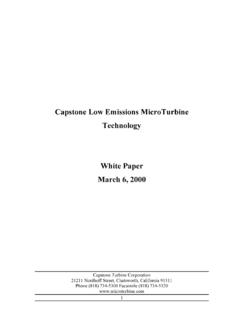Transcription of Chapter 5.2 Benzene - World Health Organization
1 WHO Regional Office for Europe, Copenhagen, Denmark, 2000 1 Chapter Benzene General description Benzene (C6H6) is a colourless liquid at room temperature (melting point oC) with a density of g/cm3 at 20 oC. It has a relatively low boiling point ( oC) and a high vapour pressure ( kPa at 20 oC), causing it to evaporate rapidly at room temperature. It is slightly soluble in water ( g/litre at 25 oC) and miscible with most organic solvents. Benzene in air exists predominately in the vapour phase, with residence times varying between a few hours and a few days, depending on the environment, the climate and the concentration of other pollutants.
2 Reaction with hydroxy radicals is the most important means of degradation. It can also be removed from air by rain. Sources Benzene is a natural component of crude oil, and petrol contains 1 5% by volume. Within the European Union the maximum allowable concentration is 5%. Benzene is produced in large quantities from petroleum sources and is used for the chemical synthesis of ethyl Benzene , phenol, cyclohexane and other substituted aromatic hydrocarbons. Production in 1988 was estimated to be 20 million tonnes worldwide and 5 million tonnes within the countries of the European Economic Community.
3 Production in the USA and Japan in 1990 was estimated to be million and million tonnes, respectively (1). Benzene is emitted during its production and from coke ovens. Besides these industrial sources, emission also occurs from different combustion sources, such as motor engines, wood combustion and stationary fossil fuel combustion. The major source is exhaust emissions and evaporation losses from motor vehicles, and evaporation losses during the handling, distribution and storage of petrol.
4 Occurrence in air Daily median air concentrations in the USA have been reported as follows: remote areas, g/m3 ( ppb); rural areas, g/m3 ( ppb); and urban/suburban areas, g/m3 ( ppb) (2). Mean concentrations from Montreal and Toronto in Canada, Houston, New York and Pittsburgh in the USA, Oslo in Norway, the Rhine area in Germany, London in England and Bilthoven in the Netherlands are in the range 40 g/m3, with Bilthoven showing the lowest figure and Oslo the highest.
5 Countrywide averages in Germany were further reported to be 1 10 g/m3. More recent data from ten Canadian cities surveyed between 1988 and 1990 have shown mean concentrations of Benzene in the range g/m3 with an overall mean value of g/m3 (3). Repeated weekly measurements during the winter of 1992 1993 in 17 towns in Sweden resulted in calculated winter mean levels in the range g/m3. Similar measurements in 22 towns during the winter of 1993 1994 gave somewhat lower winter means of g/m3 (4).
6 Mean values of Benzene in street canyons in different German cities varied between 8 and 48 g/m3 (5). Higher concentrations than those reported above can occur in certain situations, such as during the refuelling of cars. Levels of mg/m3 (1 ppm) have been measured in the breathing zone during Chapter Benzene Air Quality Guidelines - Second Edition WHO Regional Office for Europe, Copenhagen, Denmark, 2000 2 refuelling (2). Swedish measurements during refuelling have shown concentrations varying from to 27 mg/m3, depending on wind speed and local circumstances.
7 The geometric mean value from 175 measurements was mg/m3. In comparison, 30 measurements during refuelling using a vapour recovery system showed a geometric mean value of mg/m3 (6). The geometric mean personal exposure to Benzene during a work shift for 32 petrol station attendants was mg/m3, with similar values in a station using a vapour recovery system (7). Cigarette smoke is an important source of Benzene in indoor air, and median Benzene levels have been found to be higher in the homes of smokers ( g/m3) than those of nonsmokers (7 g/m3) in the USA.
8 Corresponding figures from Germany were 11 and g/m3, respectively. The levels in the USA were higher than the corresponding median outdoor concentration, 6 g/m3, and the mean personal exposure was also higher at 15 g/m3 (2, 8). The mean concentration of Benzene in indoor air in homes across Canada was g/m3, with a maximum value of 68 g/m3. The mean concentration in outdoor air was g/m3 (3). Passive sampling in households in Germany (Duisburg) showed an average concentration of Benzene in children s bedrooms of g/m3 compared to g/m3 outside the windows (9).
9 Indoor air concentrations are enhanced in dwellings near petrol stations (10). Studies of Benzene concentrations in the interior of vehicles while driving have shown values of 10 120 g/m3 in Germany, 37 57 g/m3 in Sweden, 30 115 g/m3 in the Netherlands, and mean values of 12 50 g/m3 in the USA (5). Conversion factors 1 ppm = mg/m3 1 mg/m3 = ppm Analytical methods in air Analytical methods for Benzene in air usually include absorption traps and subsequent separation by gas chromatography with detection by flame ionisation, photo-ionization or mass chromatography.
10 In recent years optical methods, such as differential optical absorption spectroscopy (DOAS), have also been applied. Unlike the other methods, which are point measurements, DOAS measures over a distance (500 1000 m) and records the mean concentration in the air in this path. However, the correlation between the two types of method is poor, DOAS usually giving higher values (11). Routes of exposure Inhalation accounts for more than 99% of the exposure of the general population, whereas intake from food and water is minimal.
















